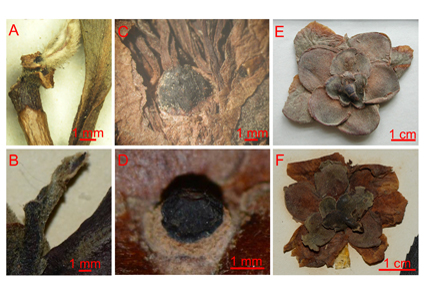Abstract
Camellia crassicolumna (Theaceae) was described as an endemic species to southeastern Yunnan, China. In the most recent monograph of Camellia, seven names, including C. crispula, C. atrothea, C. makuanica, C. haaniensis, C. purpurea, C. rotundata, and C. crassicolumna var. shangbaensis, were listed as heterotypic synonyms of C. crassicolumna. Our examination of related specimens reveals that the statement ‘ovariis pilosis’ in the protologue of C. crassicolumna is incongruent with its type specimens whose ovaries are glabrous. The morphological traits of C. crassicolumna resemble C. kwangsiensis var. kwangnanica. Therefore, C. crassicolumna is reduced into C. kwangsiensis var. kwangnanica. The species status of C. crispula is reinstated with C. atrothea, C. makuanica, C. haaniensis, C. purpurea, C. rotundata, and C. crassicolumna var. shangbaensis treated as its heterotypic synonyms. A new combination, C. crispula var. multiplex, is proposed, and the lectotype of C. atrothea is designated here.
References
<p align="justify"><span style="color: #000000;"><span style="font-family: Times New Roman, serif;"><span style="font-size: small;">Chang, H.T. (1981b) <em>A Taxonomy of the genus Camellia</em>. The Editorial Staff of the Journal of Sun Yatsen University, Guangzhou, 180 pp.</span></span></span></p>
<p align="justify"><span style="color: #000000;"><span style="font-family: Times New Roman, serif;"><span style="font-size: small;">Chang, H.T. (1984) A revision of the tea resources plants. <em>Acta Scientiarum Naturalium Universitatis Sunyatseni </em>23 (1): 1–12. </span></span></span></p>
<p align="justify"><span style="color: #000000;"><span style="font-family: Times New Roman, serif;"><span style="font-size: small;">Chang, H.T. & Bartholomew, B. (1984) <em>Camellias</em>. Timber Press, Portland, 211 pp.</span></span></span></p>
<p align="justify"><span style="color: #000000;"><span style="font-family: Times New Roman, serif;"><span style="font-size: small;">Chang, H.T. & Ren, S.X. (1998) Theaceae. <em>In</em>: Chang, H.T. (Ed.) <em>Flora Reipublicae Popularis Sinica </em>49 (3). Science Press, Beijing, 251 pp.</span></span></span></p>
<p align="justify"><span style="color: #000000;"><span style="font-family: Times New Roman, serif;"><span style="font-size: small;">Griffith, W. (1854) <em>Notulae ad plantas asiaticas</em>, part 4. printed by Charles A. Serrao, Calcutta, 764 pp. </span></span></span></p>
<p align="justify"><span style="color: #000000;"><span style="font-family: Times New Roman, serif;"><span style="font-size: small;">Linnaeus, C. (1753) <em>Species Plantarum </em>2. Holmiae: Impensis Laurentii Salvii, Stockholm, pp. 561–1200.</span></span></span></p>
<p align="justify"><span style="color: #000000;"><span style="font-family: Times New Roman, serif;"><span style="font-size: small;">Ming, T.L. (1992) A revision of <em>Camellia</em> sect. <em>Thea</em>. <em>Acta Botanica Yunnanica </em>14 (2)<em>:</em> 115–132. </span></span></span></p>
<p align="justify"><span style="color: #000000;"><span style="font-family: Times New Roman, serif;"><span style="font-size: small;">Ming, T.L. (2000) <em>Monograph of the genus Camellia</em>. Yunnan Science and Technology Press, Kunming, 352 pp. </span></span></span></p>
<p align="justify"><span style="color: #000000;"><span style="font-family: Times New Roman, serif;"><span style="font-size: small;">Ming, T.L. & Bartholomew, B. (2007) Theaceae. <em>In</em>: Wu, Z.Y., Raven, P.H. & Hong, D.Y. (eds.) <em>Flora of China</em> (Vol. 12). Science Press, Beijing and Missouri Botanical Garden Press, St. Louis, pp. 366–478. </span></span></span></p>
<p align="justify"><span style="color: #000000;"><span style="font-family: Times New Roman, serif;"><span style="font-size: small;">Sealy, J.R. (1958) <em>A revision of the genus Camellia</em>. Royal Horticultural Society, London, 239 pp.</span></span></span></p>
<p align="justify"><span style="color: #000000;"><span style="font-family: Times New Roman, serif;"><span style="font-size: small;">Thiers, B.M. (2022 [continuously updated]) Index Herbariorum: A global directory of public herbaria and associated staff. New York Botanical Garden, New York, U.S.A. Available from: http://sweetgum.nybg.org/science/ih/ (accessed 10 November 2022)</span></span></span></p>
<p align="justify"><span style="color: #000000;"><span style="font-family: Times New Roman, serif;"><span style="font-size: small;">Turland, N.J., Wiersema, J.H., Barrie, F.R., Greuter, W., Hawksworth, D.L., Herendeen, P.S., Knapp, S., Kusber, W.-H., Li, D.-Z., Marhold, K., May, T.W., McNeill, J., Monro, A.M., Prado, J., Price, M.J. & Smith, G.F. (Eds.) (2018) <em>International Code of Nomenclature for algae, fungi, and plants (Shenzhen Code)</em> <em>adopted by the Nineteenth International Botanical Congress Shenzhen, China, July 2017</em>. [Regnum Vegetabile 159]. Koeltz Botanical Books, Glashütten, 254 pp. https://doi.org/10.12705/Code.2018</span></span></span></p>
<p align="justify"><span style="color: #000000;"><span style="font-family: Times New Roman, serif;"><span style="font-size: small;">Yang, S.X. (2021) Thinking on the taxonomy of <em>Camellia</em> sect. <em>Thea</em>. <em>Journal of Tea Science</em> 41 (4): 439–453. </span></span></span></p>
<p align="justify"><span style="color: #000000;"><span style="font-family: Times New Roman, serif;"><span style="font-size: small;">Yang, S.X., Fang, W. & et Yu, X.Q. (2021) New record of <em>Camellia</em> sect. <em>Thea</em> in Guangxi—<em>Camellia crassicolumna</em> var. <em>multiplex</em>. <em>Guangxi Forestry Science</em> 50 (5): 493–495.</span></span></span></p>
<p align="justify"><span style="color: #000000;"><span style="font-family: Times New Roman, serif;"><span style="font-size: small;">Zhang, F.C. (1997) A new variety of the genus <em>Camellia </em>sect. <em>Thea</em> from Yunnan. <em>Acta Botanica Yunnanica</em> 19 (4): 437.</span></span></span></p>


